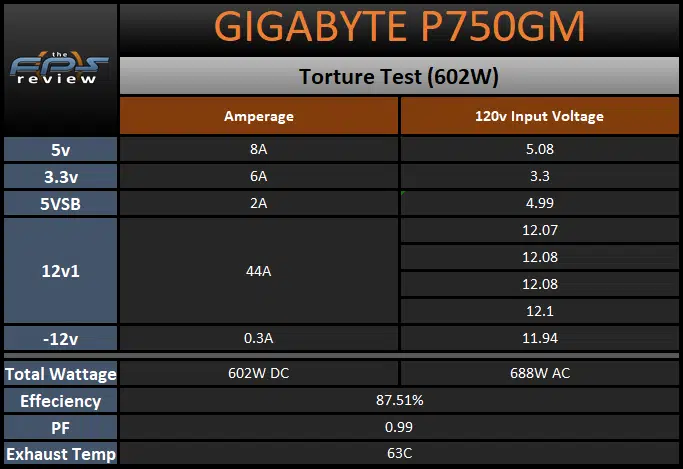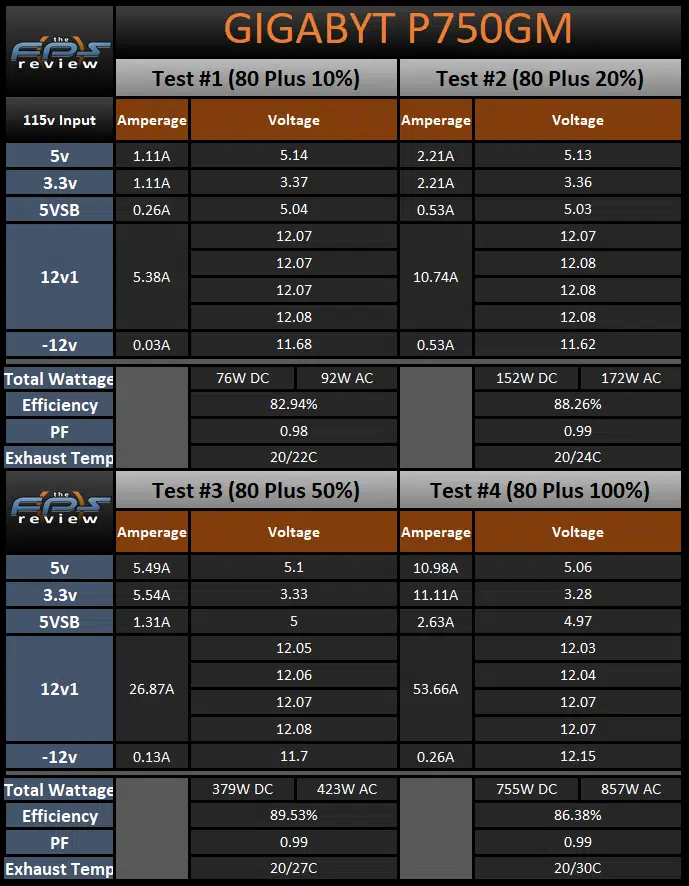Load Testing
For those of you that are curious as to some of the reasoning and equipment behind our PSU testing program here at TheFPSReview, we have put together an introduction for you. This program is based on what the author developed at [H]ardOCP and utilizes the equipment bequeathed to the author by Kyle Bennett. The testing we are conducting today is exactly as described in that document and start with our 120v, 100v, Torture, and 80 Plus Tests.
120v and 100v Load Testing Results

Test #1 is equal to approximately 25% of the rated capacity of the GIGABYTE P750GM at 45c. This makes Test #1 equal to 184W by loading the 12v rail to 13a, the 5v rail to 2a, the 3.3v rail to 1a, the +5vsb to 2a, and the -12v to 0.3a. The results of Test #1 show the main positive DC output rails starting off above nominal. The efficiency for this unit is starting off in very good shape at a value of 88.57% at 120v AC input and 87.72% at 100v AC input. We see the exhaust temperature is 48C at 120v AC input and 49C at 100V AC input.
Test #2 is equal to approximately 50% of the rated capacity of the GIGABYTE P750GM at 45c. This makes Test #2 equal to 367W by loading the 12v rail to 27a, the 5v rail to 4a, the 3.3v rail to 2a, the +5vsb to 2a, and the -12v to 0.3a. Test #2 sees mixed results in the DC output voltages relative to what we saw with Test #1. The largest changes are 0.03v drop on the 3.3v rail, up to a 0.02v drop on the 12v rail, and a 0.02v drop on the 5v rail. The efficiency has moved up to 89.72% at 120v AC input and up to 88.64% at 100v AC input. We see an exhaust temperature of 50C at 120v AC input and 53C at 100V AC input.
Test #3 is equal to approximately 75% of the rated capacity of GIGABYTE P750GM at 45c. This makes Test #3 equal to 573W by loading the 12v rail to 42a, the 5v rail to 7a, the 3.3v rail to 5a, the +5vsb to 2a, and the -12v to 0.3a. Test #3 sees the 5v and 3.3v rails drop by 0.02v while the 12v rail drops by up to 0.02v. The efficiency in Test #3 moves down to 88.32% at 120v AC input and down to 86.98% at 100v AC input. We see an exhaust temperature of 53C at 120v AC input and 55C at 100V AC input.
Test #4 is equal to approximately 100% of the rated capacity of the GIGABYTE P750GM at 45c. This makes Test #4 equal to 752W by loading the 12v rail to 60a, the 5v rail to 2a, the 3.3v rail to 1a, the +5vsb to 2a, and the -12v to 0.3a. In the final regular test, we see the 12v rail move down by up to 0.02v. The minor rails also see a small decrease of 0.02v. The efficiency has dropped as we see it come in at 86.92% at 120v AC input and 84.67% at 100v AC input. We see an exhaust temperature of 57C at 120v AC input and 60C at 100V AC input.
Torture Test

The Torture Test is equal to approximately 80% of the rated capacity of the GIGABYTE P750GM at 45C. This makes the Torture Test equal to 602W by loading the 12v rail to 44a, the 5v rail to 8a, the 3.3v rail to 6a, the +5vsb to 2a, and the -12v to 0.3a. At the end of the Torture Test, the GIGABYTE P750GM is still doing well. The DC output voltages are generally in line with what we have been seeing in the 120v load tests. The efficiency is very good as we see a value of 87.51% and the exhaust temperature is 63C.
80 Plus Load Testing Results

As we see here, the GIGABYTE P750GM posts efficiency values of 88.26%-89.53%-86.38% efficient using 80 Plus’ load testing parameters. This puts the unit right under the 80 Plus Gold standards by 0.47% in the 50% load test and 0.62% in the 100% load test. However, we do use different equipment than 80 Plus for our testing and there is always a bit of component variation.
Load Testing Summary
The GIGABYTE P750GM did a very good job in our initial load testing! When we look at the voltage regulation, we see that the GIGABYTE P750GM had peak changes of 0.04v on the 12v rail, 0.06v on the 5v rail, and 0.07v on the 3.3v rail. These absolute values are easily in the specification and very good overall. In relative terms, these results are mixed with what we saw with the Phanteks AMP 750, generally trail the ASUS ROG STRIX 750W, and trail the EVGA SuperNOVA G5 750W. Overall, that means that this unit is facing some tough competition as it was not doing better than any of the other 750W units we have seen even though its absolute values were very good.
When we look at the efficiency values posted today, we see that the GIGABYTE P750GM ranged from 86.92% to 89.72% efficient at 120v AC input and 84.67% to 88.64% efficient at 100v AC input. Also, this unit posted values in our 80 Plus Test that were just barely under the 80 Plus Gold level that it is certified for at 50% and 100% load tests. Lastly, the exhaust temperature peaked at 57C at 120v AC input, 60C at 100v AC input, and 63C during the Torture Test. These last sets of efficiency results do take some of the luster off of the load test values we saw above. So, let’s move on to the Transient Load Tests to see what this unit will do there!
